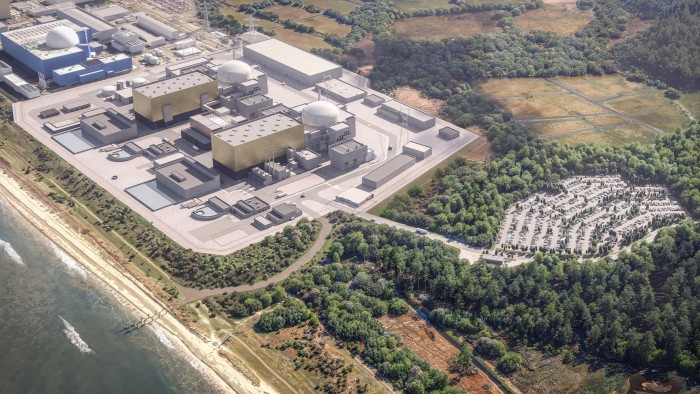Stay informed with free updates
Simply sign up to the UK energy myFT Digest — delivered directly to your inbox.
The true cost of the Sizewell C power station in Suffolk could be tens of billions of pounds higher than official government estimates once financing costs are factored in, according to official modelling seen by the Financial Times.
The UK government last week said the mostly debt-funded project would cost an estimated £38bn in real 2024 prices to build.
Under the financial structure of the deal, investors will be rewarded if the project is built for less than £40bn, and not obliged to put in further funds if costs rise above £47.7bn — which is considered unlikely.
But financial modelling — prepared as part of the wider fundraising process and seen by the Financial Times — gives a range of roughly £80bn-£100bn in nominal terms over the period of construction for the two scenarios, once debt interest and payments to shareholders are factored in.
That would imply costs of roughly £65bn-£80bn in real 2024 terms, although the exact costs will depend on inflation rates and spending rates across the lifetime of the project.
The modelling also states the revenue raised from consumer bills to help fund the project is expected to be about £35bn-£50bn in nominal terms, depending on the overall cost of the project.
This will be in the form of a surcharge on energy bills during construction, before the plant starts generating electricity. The government estimates households will pay about £1 each per month, on average, during this period.
The government’s energy department last week initially declined to share details of Sizewell C’s financing costs, saying it had not published them given how variable the costs could be.
When the FT later asked about the unpublished modelling figures, a spokesperson said the figures did not reflect consumers’ exposure to the costs, and the project would be cheaper than its sister project Hinkley Point C.
The government was the project’s biggest single investor and would recycle profits back to consumers, they added.
Sizewell C, which is due to come online in the mid- to late-2030s, is the second large-scale nuclear power project currently being built in Britain, part of an attempt by the government to revive the sector in order to bolster supplies of low-carbon electricity.
Its costs are under scrutiny given UK taxpayers’ and consumers’ hefty exposure to the project, and large cost overruns and delays at Hinkley Point C, which France’s state-owned utility EDF is building in Somerset.
Sizewell C is being built under the “regulated asset base” financing model, which is designed to encourage investment and keep financing costs down by reducing the risk to investors, as they start being paid during construction rather than having to wait until the project is built.
Private investors Centrica, La Caisse and International Public Partnerships are committing combined equity of £3.25bn, while banks backed by France’s export credit agency have committed £5bn in debt.
Centrica, which is taking a 15 per cent stake for £1.3bn, said it was expecting returns of more than 12 per cent.
But most of the funding is coming from public sources: the UK government is supplying £36.55bn in debt to be raised on the gilt market by the National Wealth Fund, as well as £3.8bn in equity, the largest portion. State-owned EDF is supplying £1.05bn and the Nuclear Liabilities Fund £400mn.
The energy department said: “Sizewell C will deliver cheaper clean electricity for generations for at least six decades, and analysis shows the project could save £2bn a year across the future low-carbon electricity system once operational.”
It added: “The £38bn cost of constructing Sizewell C will be spread between consumers, taxpayers and private investors, and represents a saving of around 20 per cent compared with Hinkley Point C, demonstrating the value of building a virtual replica project.”
#Sizewell #costs #hit #100bn #including #financing #modelling #shows


